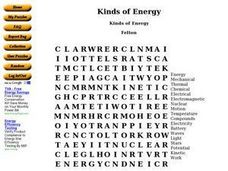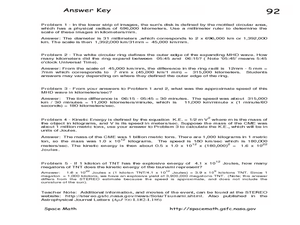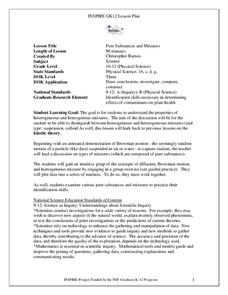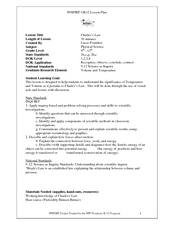Curated OER
Scientific Images & Animations
Students view a variety of scientific images and animations. They explore the world of science and visual art. Students enrich their knowledge through animation examinations of thoughts and feelings and awesome color rainbows of...
Curated OER
Ocean Absorption Lab
Students examine various techniques that can reduce carbon dioxide in the atmosphere, and use chemistry to simulate oceanic sequestration. They conduct an experiment involving the method of oceanic absorption for carbon sequestration,...
Curated OER
FORCES, MOTION, AND ENERGY
Eighth graders engage in a variety of activities in order to investigate the basic concepts of physics. They read and answer questions in a written text. This is only one type of activity that is part of many others.
Curated OER
Ultimate Ride Coaster Deluxe
Eighth graders describe the energy transformations as cars travel over a roller coaster. They explain the principle of conservation of energy as it relates to a roller coaster ride. The integration of technology is done using educational...
Curated OER
Kinds of Energy Word Search
In this energy word search puzzle, middle schoolers identify types of energy and related terms. They identify 18 words from a given list. An answer sheet is provided.
Curated OER
Circuit Basics
In this circuits worksheet, students compare voltage, current, and resistance. Students draw a battery with a resistor, switch, and light bulb. This worksheet has 6 short answer, 1 matching, and 6 drawing questions.
Curated OER
Determining Momentum and Energy Loss of Balls Colliding Against Different Surfaces
Young scholars experiment with the bounce of balls on various surfaces. In this physics lesson, students use various surfaces to bounce balls to study the momentum. This hands-on activity with the concepts of elasticity of surfaces which...
Curated OER
Simple Harmonic Motion
Students study harmonic motion and its oscillation. In this simple harmonic motion lesson students demonstrate a series of regular oscillations and explain the theory behind the experiment.
Curated OER
Energy
For this energy worksheet, students complete a crossword puzzle by determining the terms associated with the 20 given clues. Students review alternative forms of energy in this worksheet.
Curated OER
Gases
In this gases worksheet, students review the 3 states of matter, the types of molecular motion, and the characteristics of gases. This worksheet has 30 problems to solve.
Curated OER
Theatre Prop Design and Construction
Fourth graders construct individual props. In this theatrical arts lesson, 4th graders use the elements of art to create various props using paper mache. Students construct objects such as logs, fruit, and a picture frame.
Curated OER
STEREO Watches the Sun Kick up a Storm!
For this solar storm worksheet, students use images of a solar tsunami to determine the size and speed of the wave. This worksheet has 5 problems to solve.
Curated OER
Mechanical, Electrical and Radiant Energy
Students write a hypothesis and complete a lab. In this investigative lesson students complete their lab and a worksheet about energy.
Curated OER
Heat Transfer and Pollution
Students perform computer simulations on air dispersion. In this chemistry lesson, students calculate energy transfer based on specific heat and temperature change. They explain the causes of smog.
Curated OER
Pure Substances and Mixtures
Learners compare and contrast the properties of substances and mixtures. In this chemistry lesson, students simulate spontaneous mixing by performing a short class activity. They differentiate heterogeneous and homogeneous mixtures.
Curated OER
Investigation of Hooke's Law Lab
Young scholars determine the spring constant by conducting an investigation. In this physics lesson, students collect data and create a graph of force vs. displacement. They compare the results of two different methods to find spring...
Curated OER
Ballistic Pendulum Lab
Young scholars determine the muzzle velocity of projectile launcher. For this physics lesson, students compare the pendulum method and kinematic method in calculating the initial velocity. They analyze data and discuss results in class.
Curated OER
Charles’s Law
Young scholars describe the relationship between temperature and volume. For this chemistry lesson, students perform an experiment and record their their results. They use Charles' law to explain their observations.
Curated OER
Potato Launcher Energy Lab
Students investigate conservation laws using a potato launcher. In this physics lesson, students measure angles, time and distance of the potato. They discuss applications of experiments like this.
Curated OER
Where My Peeps At?
Students conduct a series of activity that demonstrates Charles' and Boyle's Law. In this chemistry lesson, students determine the relationship among pressure, volume and temperature. They solve problems using mathematical equation.
Curated OER
Alternative Energy
High schoolers identify the five major alternative energy sources. In this physical science lesson, students assess the advantages and disadvantages for each type of energy. They complete a concept map using information they researched.
Curated OER
Wind Turbines
Students build their own wind turbine. For this physics lesson, students calculate the power output of their wind turbines. They evaluate their design and make the necessary modifications.
Other popular searches
- Chemical Kinetics
- Reaction Kinetics
- Kinetics Catalysts
- Kinetics and Reaction Rates
- Kinetics and Equilibirum
- Kinetics and Equilibrium
- Kinetics Reaction Rate
- Alternative Energy Kinetics
- Kinetics and Matter
- Kinetics Theory
- Kinetics and Equilbrium























